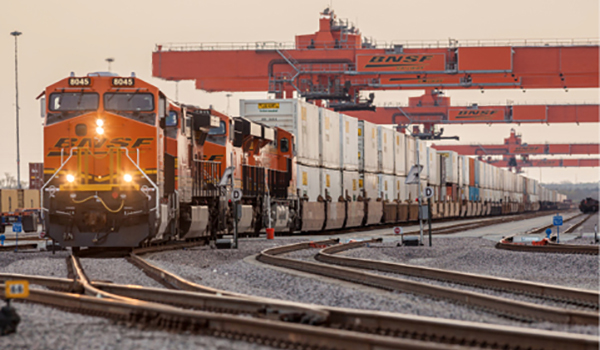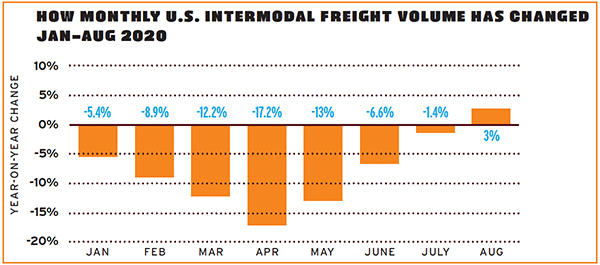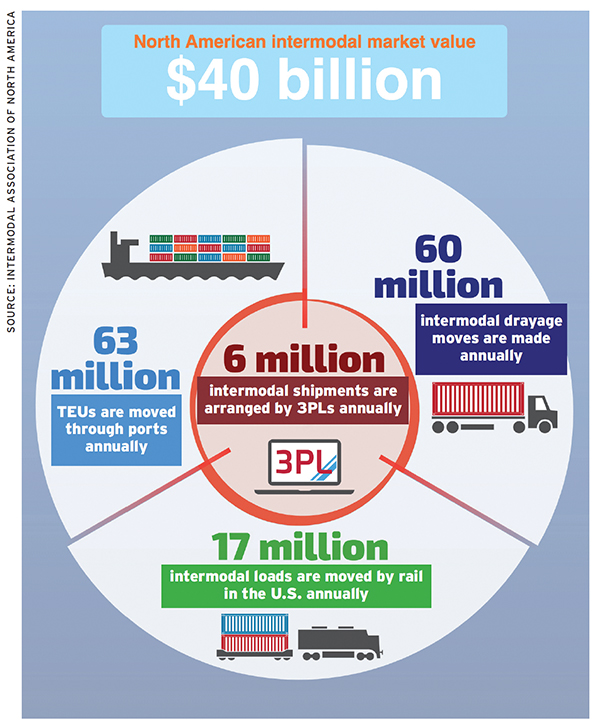How to Leverage Rail/Intermodal…Now and Later

When used smartly today and tomorrow, rail/intermodal can give supply chains a lift.
Like just about everything else in 2020, the rail and intermodal markets were upended by COVID-19. In the spring, as businesses and consumers hunkered down, the weekly volume of carloads and intermodal units dropped from about 500,000 to 400,000, only to inch back to about 500,000 by August, according to the Association of American Railroads (AAR). While carload volume for the week ending September 5, 2020, remained off 2019’s volume by about 7%, intermodal volumes were running almost 25% ahead, AAR reports.
Rapid and Strong Recovery Ahead
“The markets are recovering,” says Michael Davis, railroad sector lead with consulting firm Capgemini North America. “Add the adjectives ‘rapidly’ and ‘strongly’ and you’d probably be right, at least for now.”
As Davis suggests, it’s hard to predict where the rail and intermodal markets will head from here. “The COVID-19 pandemic has shifted what we would typically see for seasonal volume and demand,” says Tom Williams, group vice president, consumer products, with BNSF Railway.
Recently, demand at many ports along the West Coast has surged. “Our customers are using these ports to a greater degree due to the speed and flexibility they offer when importing shipments from Asia,” Williams says, noting that BNSF has seen roughly a 30% volume increase at some key hubs.
Prior to the pandemic, many East Coast ports enjoyed tremendous growth, driven largely by the expansion of the Panama Canal, says Joshua Brogan, vice president of the strategic operations practice with consulting firm Kearney. In April 2020, the Port of Wilmington, North Carolina, for instance, set a record for refrigerated container volume.
With more goods being shipped to the East Coast, truck shipments often became more cost-effective than intermodal, given that many containers were already closer to their final destination.
Yet in late summer 2020, trucking rates snapped back to their 2018 highs, due to both increased economic activity and capacity absorption from hurricanes along the Gulf Coast. “If that situation holds, interest in intermodal is sure to increase, both to offset higher pricing and to secure capacity in a tight market,” Brogan says.
Intermodal transportation, particularly with the added capacity from double-stacking containers with a rail component, can reduce highway congestion and is often a lower-cost alternative for shippers, says Joni Casey, president and chief executive officer with the Intermodal Association of North America.
Since the beginning of 2020, intermodal freight volume in the United States declined compared to the previous year, due to the COVID-19 outbreak. However, August 2020 indicated a shift: Intermodal freight was up 3% compared to August 2019.
Changing Supply Chains
The pandemic also highlighted the risks of relying on cost-focused supply chains and single sources. “More options and flexibility are part of the conversation now,” notes Steve Pastor, vice president, global supply chain and port/rail logistics with NAI James E. Hanson, a commercial real estate firm.
Similarly, the explosive growth of e-commerce in response to stay-at-home orders has shown the need for greater supply chain responsiveness. While a just-in-time approach to inventory can cut carrying costs, it can also hamstring nimbleness.
“Just-in-time is built for efficiency and speed, and not for responsiveness,” says Craig Austin, assistant professor of logistics and marketing with Florida International University.
The following guidelines can help shippers gain flexibility, act nimbly, and leverage rail/intermodal, even in today’s challenging market.
Actions to Take Now
Find trusted partners.
“Don’t use just the cheapest carriers,” recommends Mark Becker, co-founder and chief operating officer with Geneva Supply, which offers e-commerce strategy and fulfillment services. “It’s important to build relationships with carriers so they can adjust their priorities to match yours.”
Companies can become less dependent on specific railways by partnering with a third-party logistics (3PL) provider and/or intermodal marketing company (IMC) that can leverage relationships with multiple carriers.
Communicate early and often.
Constructive, ongoing discussions with transportation partners about inventories and shipping needs typically result in more successful navigation of complex supply chains. While always important, communication becomes essential during periods of upheaval.
Understand the value of each lane and mode.
By analyzing the cost, service, and reliability of each intermodal, rail, and truck lane, shippers are better prepared when requirements or markets change. Often, this requires assembling data from disparate systems, “a challenging but necessary capability” to create high-performing networks, Brogan says.
It may also require piloting new modes and lanes. Brogan provides this example: When considering a shift to intermodal shipping, it makes sense to test it with a customer that isn’t key and doesn’t enforce high on-time, in-full (OTIF) requirements. That test provides an opportunity to check whether you can manage the transit time and variability differences without risking a valuable account.
With rail, optionality—that is, selecting locations served by multiple carriers—becomes a consideration. This reduces the opportunity for monopolistic pricing that can occur when one rail company services a location.
Build a diversified transportation portfolio.
Once they understand the pros and cons of different modes and lanes, many shippers benefit by developing a “mode-shift strategy” that allows them to accommodate the current unpredictable markets. This strategy should include designing intermodal backups on appropriate lanes and establishing relationships with IMCs.
And while intermodal is typically less expensive, plan for some trucking, suggests Johnathan Foster, principal consultant with procurement specialist Proxima. If rail capacity tightens, it will be easier to shift some percentage of shipments to truck.
Leverage technology.
In the past five years, transportation companies have invested in developing better software to quote, create, and track shipments. While these capabilities aren’t available with all carriers and remain a challenge with intermodal shipments, progress continues.
“If you want to leverage your intermodal shipments you need to start using software and measuring your data,” Becker says.
Prepare for an elongated holiday season.
In the past decade or so, the holiday season has lengthened. It now includes Black Friday and Cyber Monday, with several weeks of replenishment. The last-minute December rush is less of a factor.
The pandemic will likely magnify this shift. Products will come in and leave earlier in steady, small amounts. This may require keeping more product on hand, rather than taking it to off-site storage. It may also require more frequent inventory planning sessions and “consistent dialogue with strategic capacity providers,” Foster says.
Consider the distance to be shipped.
In general, the longer the distance, the better rail looks, says Mark McKendry, vice president of North American intermodal with NFI, a supply chain solutions provider. With tighter restrictions on truck drivers’ hours of service, rail often becomes competitive from a service standpoint. It also tends to be less expensive.
Survey your carriers.
A survey of carriers, drivers, and 3PL providers can help identify ways to become a “shipper of choice,” says Brian Zirbes, business product owner with BluJay Solutions, a supply chain technologies provider.
For instance, responses might reveal a need to reduce turnaround time, perhaps by revising the dock schedule to better align appointments with labor capacity.
Amenities such as larger bathrooms for drivers often require some capital investment. However, the investment can pay dividends in the long run.
“Being a shipper of choice can have a significant impact on ease of freight coverage and rates,” Zirbes says.
Actions to Take Later
Balance labor and costs when designing the transportation network.
Distribution hubs built far from metro areas—perhaps to take advantage of lower labor costs—are generally less able to make use of rail.
“As a general rule, railroad hubs are in large urban centers,” McKendry notes. “If you’re not there, you’re more reliant on truck.”
Bring in experts when it makes sense.
Intermodal marketing companies can help shippers connect with rail companies and prepare shipments for rail transport, McKendry says. For instance, a shipment that could safely travel by truck with just a load bar or strap might require “blocking and bracing” for rail. An IMC can help.
Depending on a shipper’s size and technical capabilities, it may make sense to hire a transportation management company, Davis says. These firms have relationships with railroads, interstate trucking firms, and ocean shipping companies, as well the technical and process capabilities to move freight effectively. They also offer shipment visibility.
Give secondary ports a second look.
The ports in Alabama, Georgia, Louisiana, and Mississippi, among other states, offer reasonable turnaround times and utility rates. Many continue to improve and have land available to accommodate future growth, all of which can help them minimize delays.
Find creative ways to handle shipment volume spikes.
Once drivers leave the terminals and arrive at a warehouse or distribution center, most want to unload as quickly as possible. When volume increases, this may require leasing storage trailers or asking neighboring businesses if they have excess capacity available. “Get creative,” Foster says.
Evaluate your warehouse layouts.
At many ports and railway properties, shippers that don’t move their containers within 24 to 48 hours are hit with fees. In some cases, these shipments remain in place because the shippers lack room for them at their warehouses.
In addition, the growth in e-commerce means distribution centers and warehouses will likely need more room for parking to accommodate the larger employee base required to handle picking and packing, as well as for container storage, Pastor says.
These shifts should influence the design of future warehouses.


